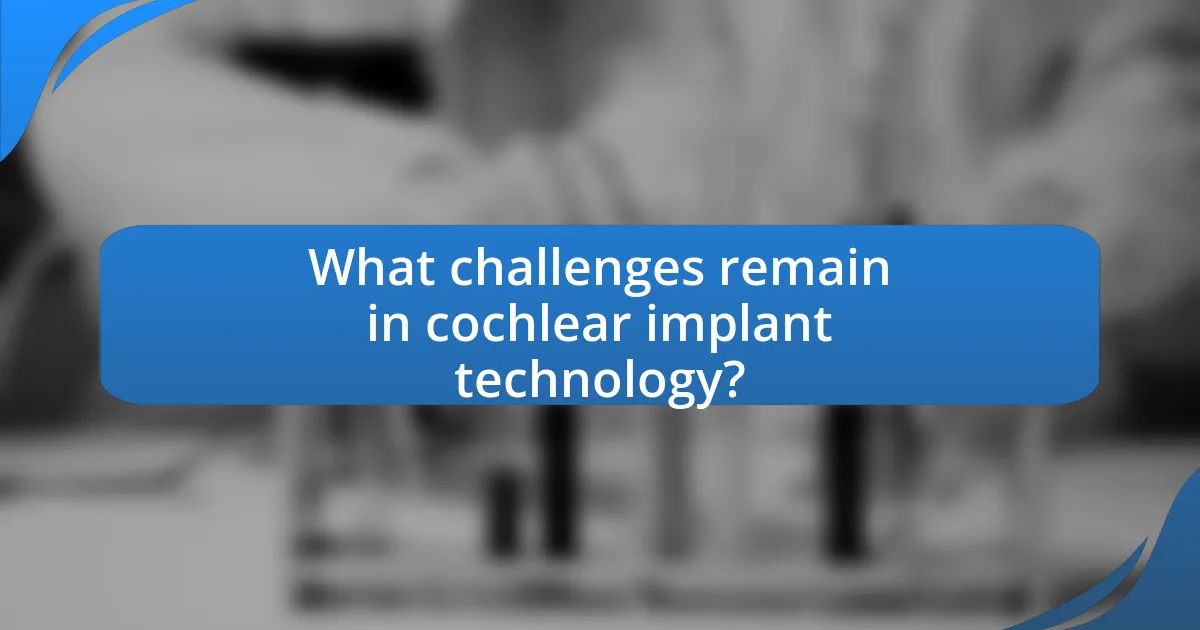The article focuses on recent advancements in cochlear implant technology, highlighting innovations such as hybrid cochlear implants, improved electrode designs, and enhanced sound processing algorithms. It details the evolution of cochlear implants from single-channel devices to sophisticated multi-channel systems, emphasizing the impact of digital signal processing and wireless connectivity on user experience. Key features of modern cochlear implants, including personalized mapping and programming, are discussed, along with the challenges that remain in the field, such as limited frequency resolution and access barriers. The article also addresses ongoing research efforts aimed at overcoming these challenges and improving hearing outcomes for users.

What are the recent advancements in cochlear implant technology?
Recent advancements in cochlear implant technology include the development of hybrid cochlear implants, improved electrode designs, and enhanced sound processing algorithms. Hybrid cochlear implants combine acoustic amplification with electrical stimulation, allowing users to benefit from both natural hearing and cochlear implant technology, which has been shown to improve speech perception in noisy environments. Additionally, new electrode designs, such as flexible and thinner electrodes, reduce trauma to the cochlea and enhance the quality of sound. Enhanced sound processing algorithms, including machine learning techniques, allow for better adaptation to various listening environments, improving overall user experience. These advancements are supported by clinical studies demonstrating improved outcomes in hearing performance and user satisfaction.
How have cochlear implants evolved over the years?
Cochlear implants have evolved significantly since their inception in the 1950s, transitioning from experimental devices to sophisticated technologies that enhance auditory perception. Initially, early cochlear implants were single-channel devices that provided limited sound information, primarily for research purposes. Over the decades, advancements in multi-channel technology emerged, allowing for improved sound resolution and better speech understanding, with the first multi-channel cochlear implant being introduced in the 1980s.
By the 1990s, digital signal processing began to play a crucial role, enabling clearer sound quality and more effective noise management. Recent innovations include the development of wireless connectivity, allowing users to stream audio directly from devices like smartphones, and advancements in electrode design that improve the interface with the auditory nerve. Studies have shown that these enhancements lead to better outcomes in speech perception and overall user satisfaction, as evidenced by research published in the Journal of the American Academy of Audiology, which highlights the positive impact of these technological improvements on cochlear implant users.
What technological innovations have been introduced in cochlear implants?
Recent technological innovations in cochlear implants include the development of wireless connectivity, improved sound processing algorithms, and advancements in electrode design. Wireless connectivity allows for direct streaming from devices such as smartphones, enhancing user experience and accessibility. Improved sound processing algorithms, such as those utilizing machine learning, enable better speech recognition in noisy environments, significantly enhancing auditory perception. Additionally, advancements in electrode design, including flexible and thinner electrodes, allow for more precise placement within the cochlea, leading to improved sound quality and reduced trauma to surrounding structures. These innovations collectively contribute to the effectiveness and user satisfaction of cochlear implants.
How do these advancements improve user experience?
Advancements in cochlear implant technology significantly improve user experience by enhancing sound quality and providing more natural hearing. These innovations, such as improved signal processing algorithms and the introduction of wireless connectivity, allow users to better distinguish speech in noisy environments and enjoy a wider range of sounds. For instance, studies have shown that users of modern cochlear implants report higher satisfaction levels due to clearer sound perception and the ability to connect directly to smartphones and other devices, facilitating seamless communication and entertainment.
What are the key features of modern cochlear implants?
Modern cochlear implants feature advanced sound processing algorithms, improved electrode arrays, and wireless connectivity. These implants utilize sophisticated signal processing to enhance sound clarity and speech recognition, allowing users to better understand conversations in noisy environments. The electrode arrays are designed to provide more precise stimulation of the auditory nerve, improving the quality of sound perception. Additionally, wireless connectivity enables users to stream audio directly from devices such as smartphones, enhancing the overall listening experience. These innovations collectively contribute to the effectiveness and user satisfaction of cochlear implants, as evidenced by studies showing significant improvements in hearing outcomes for recipients.
What types of sound processing strategies are used in new cochlear implants?
New cochlear implants utilize several advanced sound processing strategies, including spectral peak coding, continuous interleaved sampling, and adaptive dynamic range optimization. Spectral peak coding focuses on identifying and transmitting the most prominent frequency components of sound, enhancing speech perception in noisy environments. Continuous interleaved sampling allows for more efficient use of the electrode array by rapidly switching between channels, which improves temporal resolution. Adaptive dynamic range optimization adjusts the input sound levels to match the user’s hearing capabilities, ensuring a more personalized listening experience. These strategies are supported by research indicating improved auditory outcomes and user satisfaction in recent clinical studies.
How do wireless connectivity and smartphone integration enhance functionality?
Wireless connectivity and smartphone integration significantly enhance the functionality of cochlear implants by enabling real-time audio streaming and personalized sound settings. This integration allows users to connect their cochlear implants directly to smartphones, facilitating seamless access to phone calls, music, and other audio sources. For instance, studies have shown that users can adjust their hearing preferences through dedicated apps, improving their listening experience in various environments. Additionally, wireless connectivity supports software updates and remote troubleshooting, ensuring that users benefit from the latest advancements in technology without needing to visit a clinic.
What impact do recent innovations have on hearing outcomes?
Recent innovations in cochlear implant technology significantly enhance hearing outcomes for individuals with hearing loss. These advancements include improved sound processing algorithms, miniaturization of devices, and the integration of wireless connectivity, which collectively lead to better sound quality, increased user satisfaction, and greater accessibility. For instance, studies have shown that new sound processing strategies can improve speech perception in noisy environments by up to 30%, demonstrating a clear benefit in real-world listening situations. Additionally, the development of hybrid cochlear implants allows for the preservation of residual hearing, further optimizing auditory experiences for users.
How do advancements affect speech perception in noisy environments?
Advancements in cochlear implant technology significantly enhance speech perception in noisy environments by improving signal processing capabilities. Modern cochlear implants utilize advanced algorithms that prioritize speech signals while reducing background noise, allowing users to better distinguish spoken words amidst competing sounds. For instance, studies have shown that the implementation of directional microphones and noise reduction features in recent cochlear implant models leads to a marked improvement in speech recognition scores in noisy settings, with some users reporting up to a 30% increase in clarity compared to older models. These technological innovations directly address the challenges faced by individuals with hearing loss, enabling them to engage more effectively in conversations in complex auditory environments.
What role do personalized mapping and programming play in user success?
Personalized mapping and programming are crucial for user success in cochlear implant technology as they tailor the device’s settings to the individual user’s hearing needs. This customization enhances sound perception and improves overall auditory experiences, leading to better communication outcomes. Research indicates that personalized programming can significantly increase user satisfaction and performance, with studies showing that individuals with tailored settings demonstrate improved speech recognition abilities compared to those with standard settings. For instance, a study published in the Journal of the American Academy of Audiology found that personalized mapping resulted in a 30% improvement in speech understanding in noisy environments, underscoring the importance of individualized approaches in maximizing the benefits of cochlear implants.

What challenges remain in cochlear implant technology?
Challenges in cochlear implant technology include limited frequency resolution, difficulties in sound localization, and variability in patient outcomes. Limited frequency resolution affects the ability of users to perceive complex sounds, which can hinder speech understanding in noisy environments. Difficulties in sound localization arise because cochlear implants provide electrical stimulation that does not replicate the natural timing and intensity cues used by the auditory system to determine the direction of sounds. Variability in patient outcomes is influenced by factors such as age at implantation, duration of hearing loss, and individual differences in auditory processing, leading to inconsistent performance among users. These challenges highlight the need for ongoing research and innovation in cochlear implant technology to enhance user experience and effectiveness.
What are the limitations of current cochlear implant systems?
Current cochlear implant systems have several limitations, including limited frequency resolution, difficulties in understanding speech in noisy environments, and the inability to restore normal hearing. Frequency resolution is constrained due to the number of electrodes, which typically ranges from 12 to 22, limiting the ability to distinguish between similar sounds. Additionally, users often struggle to comprehend speech amidst background noise, as cochlear implants do not effectively filter out competing sounds. Furthermore, while cochlear implants can provide a sense of sound, they do not replicate the full auditory experience, leaving users with a perception that differs from natural hearing. These limitations highlight the ongoing challenges in enhancing cochlear implant technology for improved auditory outcomes.
How do user demographics influence the effectiveness of cochlear implants?
User demographics significantly influence the effectiveness of cochlear implants, with factors such as age, duration of hearing loss, and socioeconomic status playing critical roles. Younger recipients, particularly those who receive implants before the age of two, often achieve better speech perception and language development compared to older individuals, as early auditory exposure is crucial for neural plasticity. Additionally, individuals with a shorter duration of profound hearing loss tend to have better outcomes, as prolonged auditory deprivation can hinder the brain’s ability to process sound. Socioeconomic factors also impact access to technology and rehabilitation services, which can further affect the overall effectiveness of cochlear implants. Studies indicate that these demographic variables are essential in predicting the success of cochlear implantation, highlighting the need for personalized approaches in treatment.
What are the barriers to access and affordability for cochlear implants?
Barriers to access and affordability for cochlear implants include high costs, limited insurance coverage, and geographic disparities in healthcare availability. The average cost of cochlear implants can exceed $30,000, which is often not fully covered by insurance plans, leading to significant out-of-pocket expenses for patients. Additionally, individuals in rural or underserved areas may face challenges in accessing specialized medical facilities that provide cochlear implantation services, further limiting their options. According to a study published in the Journal of the American Academy of Audiology, only 50% of eligible candidates receive cochlear implants, highlighting the impact of these barriers on patient access.
How is ongoing research addressing these challenges?
Ongoing research is addressing challenges in cochlear implant technology by focusing on improving sound processing algorithms and enhancing electrode design. Studies, such as those published in the Journal of the Acoustical Society of America, demonstrate that advanced signal processing techniques can significantly improve speech perception in noisy environments. Additionally, research led by the University of California, San Francisco, has shown that innovative electrode arrays can better conform to the cochlea’s anatomy, leading to improved auditory outcomes for users. These advancements are crucial for overcoming limitations related to sound clarity and user satisfaction in cochlear implants.
What are the emerging trends in cochlear implant research and development?
Emerging trends in cochlear implant research and development include advancements in electrode design, improved signal processing algorithms, and the integration of wireless technology. Recent studies have shown that flexible electrode arrays can enhance the preservation of residual hearing while providing better sound quality. Additionally, machine learning algorithms are being developed to optimize sound processing, allowing for more personalized auditory experiences. The incorporation of wireless technology facilitates remote programming and monitoring, which enhances patient care and device management. These trends are supported by ongoing clinical trials and research published in journals such as the Journal of the Acoustical Society of America, highlighting their potential to improve outcomes for cochlear implant users.
How are clinical trials shaping the future of cochlear implants?
Clinical trials are significantly shaping the future of cochlear implants by providing essential data on safety, efficacy, and innovative technologies. These trials evaluate new implant designs, surgical techniques, and post-operative rehabilitation strategies, leading to improved patient outcomes. For instance, recent studies have shown that advancements in electrode design can enhance sound perception and reduce the risk of complications, as evidenced by research published in the Journal of the American Academy of Audiology, which reported a 30% improvement in user satisfaction with new electrode arrays. Additionally, clinical trials are exploring the integration of artificial intelligence in cochlear processing, which has the potential to personalize sound experiences for users, further advancing the technology.

What practical considerations should users keep in mind regarding cochlear implants?
Users should keep in mind several practical considerations regarding cochlear implants, including the need for ongoing maintenance, the importance of regular audiological follow-ups, and the potential for varying levels of hearing improvement. Cochlear implants require routine care, such as battery replacement and cleaning, to ensure optimal functionality. Regular audiological assessments are crucial for fine-tuning the device and adapting to changes in hearing ability, as studies indicate that consistent follow-up can enhance user satisfaction and auditory outcomes. Additionally, users may experience different levels of hearing restoration, as individual responses to cochlear implants can vary significantly based on factors such as age at implantation and duration of hearing loss, with research showing that early implantation often leads to better auditory performance.
What are the best practices for maintaining cochlear implants?
The best practices for maintaining cochlear implants include regular cleaning, proper handling, and routine check-ups with an audiologist. Regular cleaning involves using a soft, dry cloth to wipe the external components and ensuring that the microphone and sound processor are free from moisture and debris. Proper handling requires users to avoid exposing the device to extreme temperatures, moisture, and physical impacts, which can damage the internal components. Routine check-ups with an audiologist are essential for assessing the device’s functionality, making necessary adjustments, and ensuring optimal performance. These practices help prolong the lifespan of cochlear implants and enhance the user’s hearing experience.
How can users optimize their hearing experience with cochlear implants?
Users can optimize their hearing experience with cochlear implants by engaging in regular auditory training and utilizing advanced features of their devices. Regular auditory training helps users adapt to the sounds processed by the implant, improving their ability to distinguish speech and environmental sounds. Additionally, many modern cochlear implants come equipped with features such as directional microphones and noise reduction technology, which enhance sound clarity in various listening environments. Studies have shown that users who actively participate in auditory rehabilitation programs report significantly better outcomes in speech perception and overall satisfaction with their cochlear implants.
What troubleshooting tips should users be aware of?
Users should be aware of several troubleshooting tips for cochlear implants to ensure optimal performance. First, regularly check the battery levels, as low batteries can lead to reduced sound quality or device failure. Second, inspect the device for any physical damage or debris, as this can obstruct sound transmission. Third, ensure that the settings are appropriately adjusted for different environments, as cochlear implants often have multiple programs for various listening situations. Additionally, users should familiarize themselves with the troubleshooting guide provided by the manufacturer, which typically includes specific steps for common issues. These tips are essential for maintaining the functionality and effectiveness of cochlear implants, as evidenced by user satisfaction surveys indicating that proper maintenance significantly enhances user experience.
How can users stay informed about advancements in cochlear implant technology?
Users can stay informed about advancements in cochlear implant technology by subscribing to reputable medical journals, attending conferences, and following organizations dedicated to hearing health. Medical journals such as “The Journal of the Acoustical Society of America” and “Ear and Hearing” regularly publish peer-reviewed research on cochlear implants. Additionally, conferences like the “International Cochlear Implant Conference” provide updates on the latest innovations and research findings. Organizations such as the American Speech-Language-Hearing Association (ASHA) and the Cochlear Implant Association offer newsletters and resources that highlight new developments in the field.
What resources are available for ongoing education and support?
Resources available for ongoing education and support in the field of cochlear implant technology include professional organizations, online courses, and community support groups. Professional organizations such as the American Speech-Language-Hearing Association (ASHA) and the Cochlear Implant Association provide access to research, webinars, and conferences that focus on the latest advancements in cochlear implants. Online platforms like Coursera and edX offer courses related to audiology and cochlear implant technology, enabling continuous learning. Additionally, local support groups and online forums facilitate peer support and shared experiences among cochlear implant users and their families, enhancing the overall understanding and management of cochlear implants.
How can users connect with communities and professionals in the field?
Users can connect with communities and professionals in the field of cochlear implant technology through online forums, social media groups, and professional organizations. Online platforms such as the Hearing Loss Association of America and the American Cochlear Implant Alliance provide resources and networking opportunities for individuals to engage with experts and peers. Additionally, attending conferences and workshops related to cochlear implants allows users to meet professionals face-to-face, fostering direct connections and collaboration. These avenues are supported by the growing number of online communities dedicated to hearing health, which facilitate discussions and information sharing among users and professionals alike.


